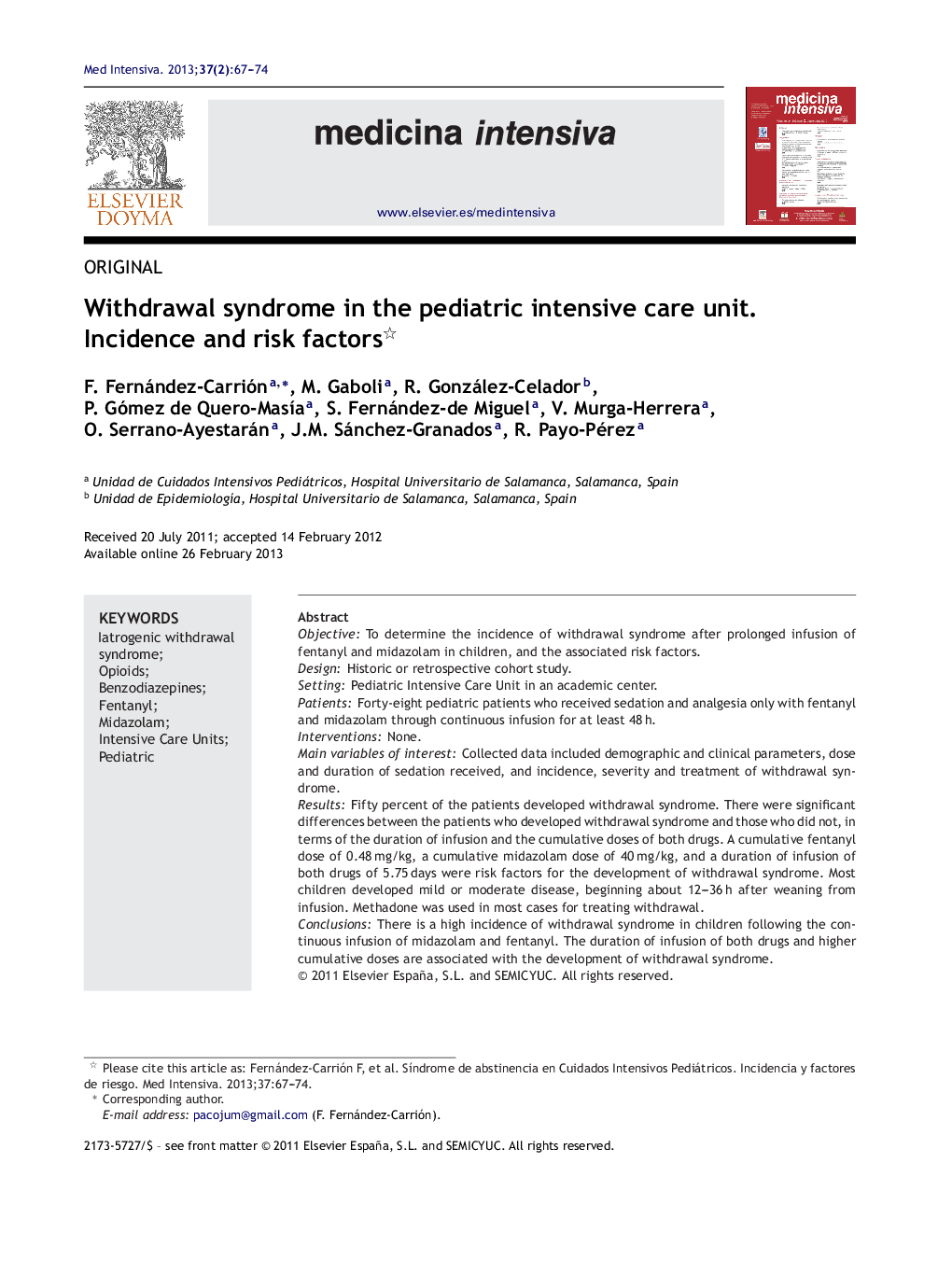| Article ID | Journal | Published Year | Pages | File Type |
|---|---|---|---|---|
| 3114246 | Medicina Intensiva (English Edition) | 2013 | 8 Pages |
ObjectiveTo determine the incidence of withdrawal syndrome after prolonged infusion of fentanyl and midazolam in children, and the associated risk factors.DesignHistoric or retrospective cohort study.SettingPediatric Intensive Care Unit in an academic center.PatientsForty-eight pediatric patients who received sedation and analgesia only with fentanyl and midazolam through continuous infusion for at least 48 h.InterventionsNone.Main variables of interestCollected data included demographic and clinical parameters, dose and duration of sedation received, and incidence, severity and treatment of withdrawal syndrome.ResultsFifty percent of the patients developed withdrawal syndrome. There were significant differences between the patients who developed withdrawal syndrome and those who did not, in terms of the duration of infusion and the cumulative doses of both drugs. A cumulative fentanyl dose of 0.48 mg/kg, a cumulative midazolam dose of 40 mg/kg, and a duration of infusion of both drugs of 5.75 days were risk factors for the development of withdrawal syndrome. Most children developed mild or moderate disease, beginning about 12–36 h after weaning from infusion. Methadone was used in most cases for treating withdrawal.ConclusionsThere is a high incidence of withdrawal syndrome in children following the continuous infusion of midazolam and fentanyl. The duration of infusion of both drugs and higher cumulative doses are associated with the development of withdrawal syndrome.
ResumenObjetivoConocer la incidencia de síndrome de abstinencia tras perfusión prolongada de fentanilo y midazolam en niños, y los factores de riesgo asociados.DiseñoEstudio de cohorte histórica o retrospectiva.ÁmbitoUCI pediátrica de seis camas de un hospital universitario.PacientesSe incluyen 48 pacientes pediátricos que recibieron sedoanalgesia en perfusión continua con midazolam y fentanilo exclusivamente, durante al menos 48 horas.IntervencionesNinguna.Variables de interés principalesSe recogen datos clínicos y demográficos, dosis y duración de sedoanalgesia recibida, aparición de síndrome de abstinencia, gravedad y tratamiento del mismo.ResultadosEl 50% desarrolló síndrome de abstinencia. Hubo diferencias significativas entre los que lo desarrollaron y los que no en cuanto a duración del tratamiento previo y dosis acumulada de ambos fármacos. Una dosis acumulada de fentanilo de 0,48 mg/kg o de midazolam de 40 mg/kg, y una duración de la perfusión de ambos de 5,75 días fueron factores de riesgo para el desarrollo de abstinencia. La mayoría presentó un cuadro leve o moderado, que comenzó a las 12-36 horas de suspender la perfusión. El fármaco más utilizado en el tratamiento fue la metadona.ConclusionesLa incidencia de síndrome de abstinencia en niños tras perfusión prolongada de midazolam y fentanilo es elevada. El desarrollo del síndrome se relaciona con tiempos de perfusión prolongados y con dosis acumuladas elevadas de ambos fármacos.
